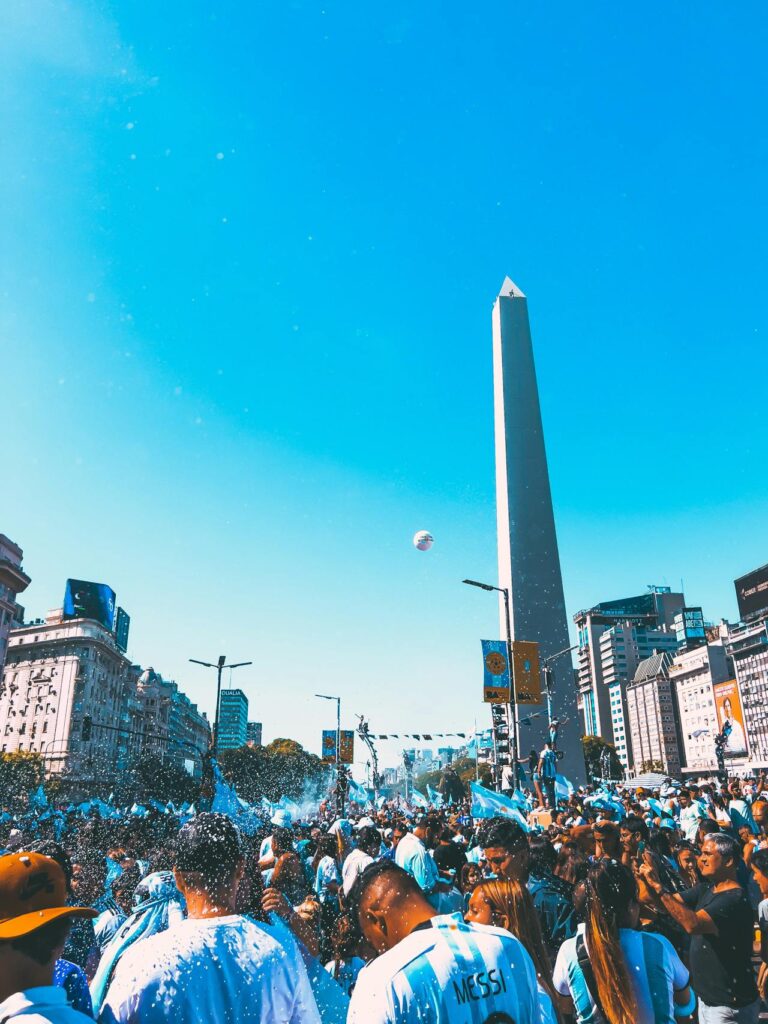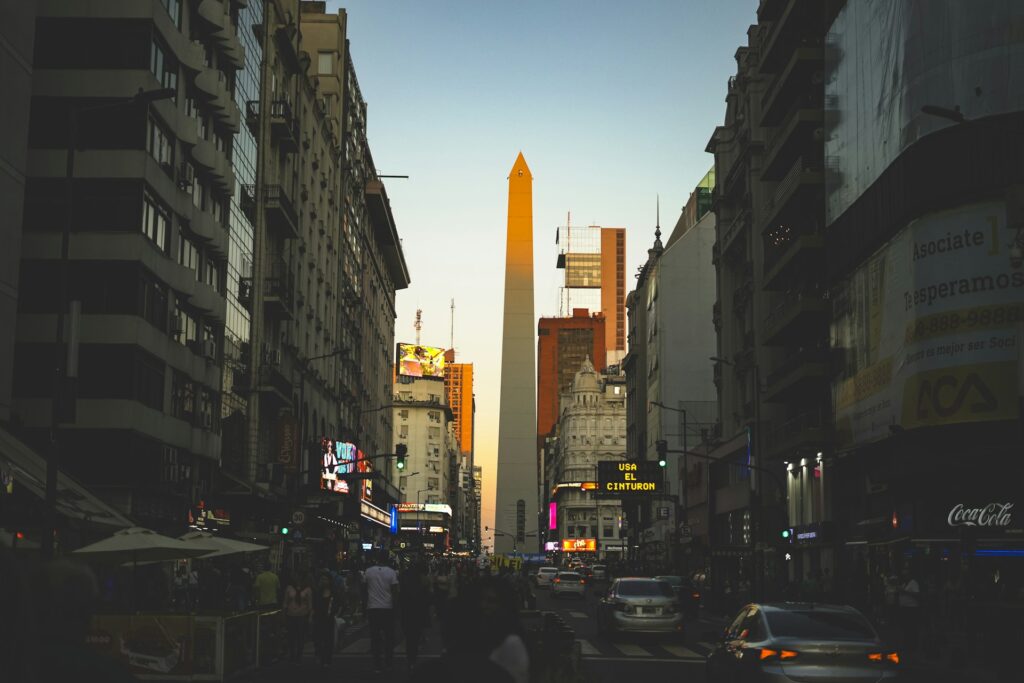Buenos Aires wouldn’t be Buenos Aires without its beloved Obelisco. Standing at 67 metres, it’s been an icon of Argentina’s capital for almost 88 years and has become a staging ground for celebrations and protests on countless occasions; not to mention being a first stop for tourists. When Argentina won the World Cup in 2022, millions crowded around the Obelisco to celebrate and covered the surrounding streets.
Construction (and near demolition) of the Obelisco
Buenos Aires’ Obelisco was inaugurated on 23rd May 1936, during the presidency of Agustín Pedro Justo.
Where the monument now stands, there had originally been a church, La Iglesia de San Nicolás de Bari, which had stood since 1733. When the mayor of Buenos Aires, Mariano de Vedia y Mitre, announced plans to modernise the city, his ideas generated mixed feelings amongst the people of Buenos Aires. The controversy surrounding the demolition of La Iglesia de San Nicolás de Bari stemmed from the fact that the church had been of great historical significance to the City of Buenos Aires, with many traditionalists opposed to the Obelisco.
San Nicolás de Bari’s replacement also signified a further cutting of ties with Argentina’s Spanish heritage, as the church had been built at the time during which the Spanish Empire controlled Argentina.

Picture: La Iglesia de San Nicolás de Bari. (Fundación Antorchas).
The idea behind the Obelisco was to give the City of Buenos Aires a modern-looking monument, with the hopes of it becoming an emblem of the city. Furthermore, in 1936 Buenos Aires would also reach the 400-year mark since its founding in 1536 – the Obelisco would become a symbol of this too.
The construction of the monument was very quick, beginning on 20th March 1936 and finishing with the inauguration on 23rd May of the same year. Alberto Prebisch had been placed in charge as the architect for the project, and a further 157 workers from the German company GEOPÉ took part in the build, one of which, José Consentino, sadly died in the process. The cost of the project was around 200,000 pesos.
Just three years after the inauguration of the Obelisco, a vote was held among the councillors of the City of Buenos Aires to decide whether it should be demolished.
The council had decided that the monument posed a safety risk as several pieces of slate had become dislodged from the top and fallen to the ground. Demolition was seen as the best option as they didn’t want to spend money on continuous repairs. A public debate was sparked following the decision, with many disagreeing with the plan. Defenders of the Obelisco argued that not only would its demolition be a big financial cost, but that it wouldn’t make sense as since its inauguration, the Obelisco had already become an important landmark and a favourite destination for tourists. By 1939, many businesses surrounding the Obelisco would use it as a point of reference for customers, declaring they were “opposite the Obelisco”.
The vote was held in June of 1939 and 23 councillors voted in favour of the demolition, with just 3 opposing it. From the date of the vote, there would be just 10 days before the demolition would take place, and in those 10 days, there was much opposition to the decision. Many politicians outside of the City of Buenos Aires argued that the decision of whether to demolish the Obelisco was one that concerned the entire country, not just Buenos Aires. In the end, the mayor of Buenos Aires, Arturo Goyeneche, vetoed the decision and the Obelisco survived.
The importance of the Obelisco today

Nowadays, the Obelisco is used as a place to celebrate, parade and protest. The Obelisco finds itself in the crossing point between the avenues 9 de Julio and Corrientes – two of Buenos Aires’ most important and busiest streets.
Following Argentina’s win at the 2022 World Cup, millions paraded the streets of Buenos Aires in celebration, and the Obelisco was the point around which everyone crowded. Holograms were projected onto the sides of the monument, reading things like: “¡CAMPEONES DEL MUNDO!” and, “¡GRACIAS EQUIPO!”. Many overexcited fans found a way to break into the Obelisco too, with a few climbing right to the top and one man hanging off the side!
If you visit Buenos Aires, it’s likely that you’ll see protests going on around the Obelisco too. Sometimes, these protests do get out of hand and cause traffic to be at a standstill. Given that 9 de Julio is probably the busiest street of the city, it’s not an ideal place to get stuck during a protest!
Visiting the Obelisco
The Obelisco is one of the main tourist destinations of Buenos Aires, and if you’re visiting the city, you should definitely pay the monument a visit. Although it’s generally not possible to go inside and climb the 206 steps to the top, it’s still a great place to stop and get a quick photo!
Again, the exact location of the Obelisco is at the crossing point between the streets 9 de Julio and Corrientes. There are several subway stops that can take you there, as well as bus routes. In the area surrounding the Obelisco, you should be aware of your surroundings and take care of your belongings. There are lots of thieves that operate in the area and if you’re not careful, you could find yourself missing a phone or wallet later on. That’s not to say that the area is dangerous, but it’s best to have your wits about you!
Near the Obelisco, there are plenty of things to do too. The street Corrientes is known for its theatres and musicals – it’s definitely worth checking to see if there’s anything good on during your time in Buenos Aires. Everyone should experience a night at the theatre, followed by a pizza and some drinks at the world famous Pizzería Güerrín! There’s also plenty of sky bars in Buenos Aires with views of the Obelisco – another great way to finish off (or begin) a night in the city!

Have you visited the Obelisco? Do you have any recommendations of things to do near the monument? Leave a comment below with any suggestions or questions!


Wow! 😱👏🏻 Amazing!!! How nice to know that there are foreign people who enjoy our beautiful country so much. Congratulations, James!